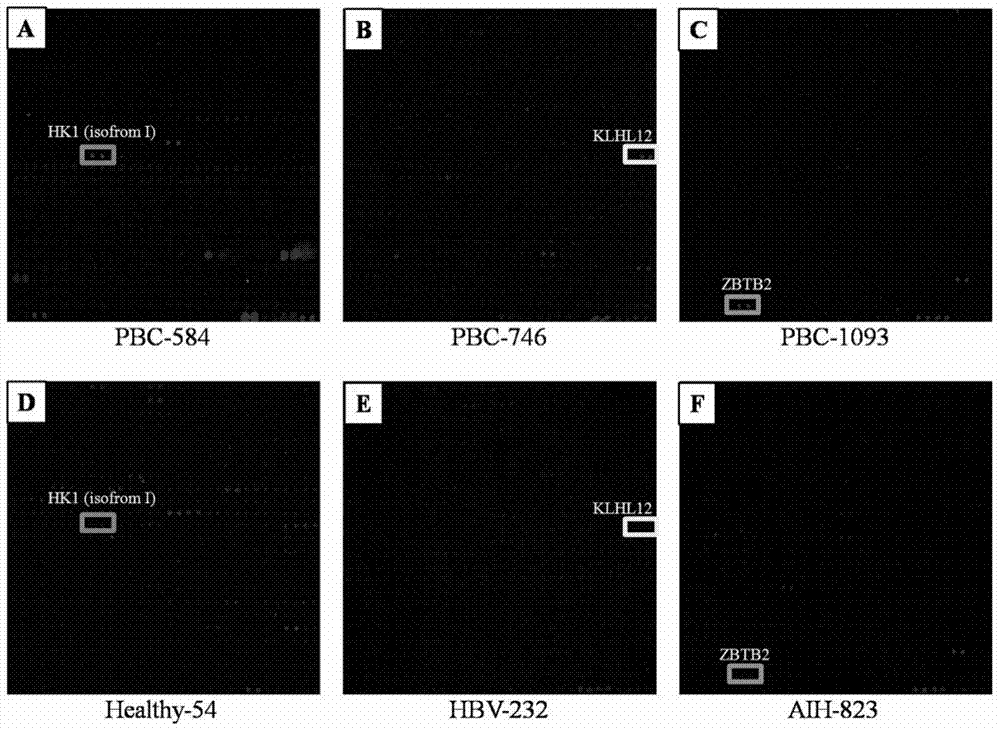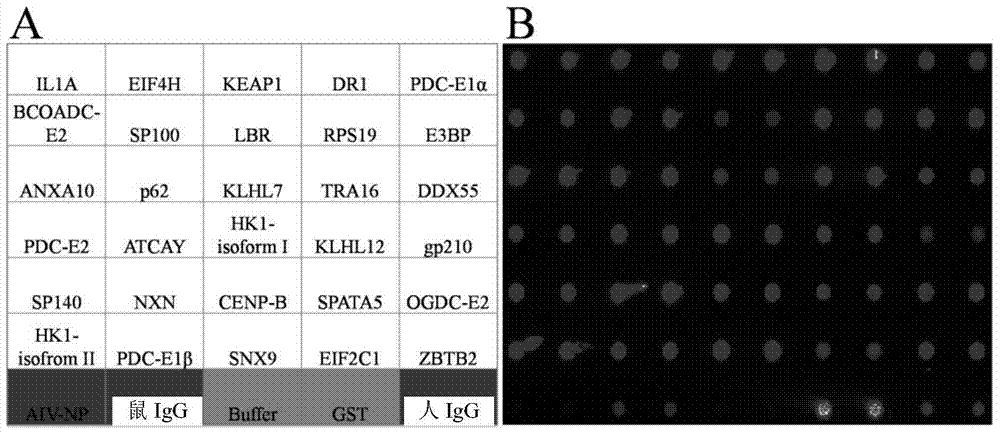Specific autoantigen of primary biliary cirrhosis (PBC) and application thereof
A technology for biliary cirrhosis and autoantigens, applied in the field of biomarkers, can solve the problems such as disputes and insufficient understanding of the role of antibodies
- Summary
- Abstract
- Description
- Claims
- Application Information
AI Technical Summary
Problems solved by technology
Method used
Image
Examples
Embodiment 1
[0038] Example 1 Screening of candidate PBC-related autoantigens using high-density protein chips
[0039] The high-density protein chip was provided by Professor Zhu Heng's laboratory at Johns Hopkins University. Each high-density protein chip contains 48 matrices, each of which contains 800 probes, arranged in a 32X25 array. There is one parallel spot for each protein probe on the chip, which contains 16,368 recombinant proteins. Most of the recombinant proteins are derived from the full-length ORF of the corresponding gene expressed by the Saccharomyces cerevisiae host and have a GST tag at the N-terminus (Jeong, 2012). The high-density protein chip has been disclosed in Jeong et al., Rapid Identification of Monospecific Monoclonal Antibodies Using a Human Proteome Microarray, Molecular & Cellular Proteomics (published online on February 3, 2012), and those skilled in the art can prepare accordingly.
[0040] Since the N-terminus of all protein probes on the chip is tagge...
Embodiment 2
[0067] Example 2 Construction of PBC autoantigen protein chip and verification of serum screening
[0068] Using Example 1 to screen to obtain 23 candidate PBC autoantigens and 9 PBC specific autoantibody markers known clinically or reported in the literature in recent years to prepare a PBC chip, there are 32 recombinant protein antigens planned to be expressed in the chip. However, due to some uncontrollable factors, 30 PBC-related autoantigens among them were continued to be studied in this example (Table 2).
[0069] The above 30 protein antigens were re-expressed and purified for the preparation of PBC-related antigen protein chips. image 3 -A is the lattice layout of 30 PBC-related autoantigens and control probes on a small chip. In addition to 30 PBC-related autoantigen probes, positive control probes were also included: 1) AIV-NP (avian influenza virus-Nucleoprotein, avian influenza virus nucleoprotein); 2) mouse IgG (mouse anti-human IgG antibody); 3) Human IgG and...
Embodiment 3
[0090] Example 3 ELISA verification of newly discovered autoantigens
[0091] In view of the high sensitivity and specificity of HK1 isoform I, HK1 isoform II, KLHL12, KLHL7 and ZBTB2 for the diagnosis of PBC in the chiplet results (EIF2C1 has similar detection sensitivity in PBC and SLE, 15.2% vs 15.6%), it was decided to use These newly identified autoantigens were detected by ELISA method commonly used in clinic. In addition, since HK1 isoform I and HK1 isoform II differ only in the N-terminal 21 amino acids in sequence, and the performance of the two in the small chip is basically the same, the antigens of the ELISA plate prepared here include HK1 isoform I, KLHL12, For KLHL7 and ZBTB2, the coating concentrations were 200ng / well, 75ng / well, 200ng / well and 50ng / well, respectively.
[0092] For the detection of two autoantigens, KLHL12 and ZBTB2 ( Figure 7 ). The samples tested by ELISA included 934 sera: 53 AIH patient sera, 112 HBV patient sera, 54 HCV patient sera, 87...
PUM
 Login to View More
Login to View More Abstract
Description
Claims
Application Information
 Login to View More
Login to View More - R&D
- Intellectual Property
- Life Sciences
- Materials
- Tech Scout
- Unparalleled Data Quality
- Higher Quality Content
- 60% Fewer Hallucinations
Browse by: Latest US Patents, China's latest patents, Technical Efficacy Thesaurus, Application Domain, Technology Topic, Popular Technical Reports.
© 2025 PatSnap. All rights reserved.Legal|Privacy policy|Modern Slavery Act Transparency Statement|Sitemap|About US| Contact US: help@patsnap.com



